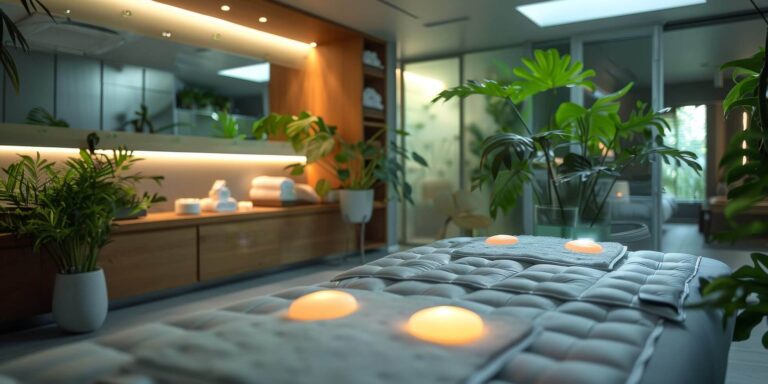Thermotherapy is a treatment that uses heat and cold for therapeutic purposes. It is used in aesthetic medicine, physiotherapy, rehabilitation, and other fields to alleviate pain, reduce inflammation, improve circulation and mobility, and accelerate injury recovery.
Although thermotherapy has numerous benefits, it can also present some risks and side effects, especially if not applied correctly. In this article, we will analyze the main contraindications and adverse effects that must be taken into account when undergoing thermotherapy treatment.
Contraindications of Thermotherapy
There are certain conditions and circumstances in which the application of heat or cold could be harmful or not recommended. It is important that the therapist carefully evaluates each patient to determine if there are any contraindications before starting a thermotherapy treatment.
Pregnancy
During pregnancy, thermotherapy is only recommended under medical supervision. Excessive heat can be dangerous for both the mother and the fetus, especially in the first trimester. Therefore, pregnant women should avoid saunas, hot baths, thermal pads on the abdomen, and other treatments that raise body temperature.
Children
In young children, the thermoregulatory system is not yet fully developed, so they are more susceptible to burns and overheating. Thermotherapy treatments should be applied with extreme care and under supervision in children under 5 years of age. The use of saunas, steam baths, and other heat therapies is contraindicated.
Cardiovascular Diseases
People with certain cardiovascular diseases, such as congestive heart failure or heart rhythm disorders, have a higher risk of complications with the application of heat and cold. Therefore, it is recommended to take extreme precautions or avoid thermotherapy depending on each specific case.
Diabetes
Patients with diabetes have difficulties regulating their body temperature and may suffer skin injuries without noticing. Excessive heat or cold could cause tissue damage. It is necessary to closely monitor the diabetic patient’s response to any thermotherapy treatment.
Neurological Diseases
Pathologies that affect the nervous system, such as multiple sclerosis, epilepsy, or strokes, can alter normal sensitivity to heat and cold. Patients with neurological diseases require close monitoring during thermotherapy to avoid burns or tissue freezing.
Acute Infections
In the presence of an active infection or fever, the use of heat is contraindicated. It could aggravate inflammation and worsen the infection. Only cryotherapy is recommended under strict supervision in acute infections.
Areas of Damaged Skin
It is necessary to avoid applying heat or cold to areas of damaged skin, such as burns, open wounds, dermatitis, etc. It could cause further tissue damage. It is necessary to wait for these lesions to heal completely before subjecting the area to any type of thermotherapy.
Sensory Disorders
People with certain neurological disorders that reduce sensitivity to heat or cold, such as diabetic neuropathy or spinal cord injury, have a higher risk of suffering burns or freezing during thermotherapy. It is advisable to take extreme precautions in these cases.

Common Side Effects of Thermotherapy
In addition to the above contraindications, the application of heat or cold can cause some adverse side effects, especially when used improperly. Some of the most common are:
Burns
The main risk is suffering burns on the skin due to excessive exposure to heat. They can occur with thermal pads, heat lamps, saunas, etc. It is essential to control the temperature and duration of the treatment properly.
Freezing
The excessive application of cold can damage tissues and cause accidental freezing. The body’s extremities are most prone to this. The skin must be closely monitored during cryotherapy.
Muscle Pain
If not dosed properly, heat and cold can cause pain and even muscle cramps. It is necessary to start with short periods and gradually increase the duration of thermotherapy.
Electrolyte Imbalances
Excessive sweating in thermal treatments such as saunas can cause loss of salts and electrolyte imbalances. It is important to stay well hydrated before and after the session.
Dizziness and Fainting
The application of heat dilates blood vessels. In some people, this can cause dizziness and even fainting due to hypotension, especially when standing up after the therapy. It is necessary to do it slowly.
Skin Alterations
Extreme heat and cold can irritate and inflame the skin, causing erythema, rashes, itching, and peeling. This is a temporary effect, but it is necessary to alert if it persists.
Thermal Stress
Prolonged exposure to very high temperatures can lead to thermal stress, with symptoms such as headaches, nausea, cramps, and even heat stroke. It is essential not to exceed the recommended treatment time.

Contraindications of Thermotherapy:
- Pregnancy
- Young children
- Cardiovascular diseases
- Diabetes
- Neurological diseases
- Acute infections
- Areas of damaged skin
- Sensory disorders
Side Effects of Thermotherapy:
- Burns
- Freezing
- Muscle pain
- Electrolyte imbalances
- Dizziness and fainting
- Skin alterations
- Thermal stress
Safety Precautions and Recommendations for Thermotherapy
To enjoy the benefits of thermotherapy while minimizing potential risks, it is important to take these basic precautions into account:
- Consult a doctor before undergoing any treatment, especially if you have chronic conditions.
- Do not apply heat or cold to areas of irritated skin, open wounds, or insensitive areas.
- Start with short 5-10 minute sessions and gradually increase the duration.
- Drink water before, during, and after treatment to stay hydrated.
- Do not use thermal pads while sleeping and remove them if they cause discomfort.
- Control the temperature and do not exceed 40°C in heat treatments.
- Avoid abrupt temperature changes and wait a few minutes between applying heat and cold.
- Do not use saunas or hot baths for more than 15 minutes, especially at the beginning.
- Leave immediately if you experience dizziness, intense pain, or burns.
- Enter and exit cryogenic chambers with caution and progressively.
- Use protective gloves and socks for localized cold treatments.
- Do not apply ice packs directly to the skin or for more than 20 consecutive minutes.
By following these recommendations and the therapist’s instructions, harmful effects can be avoided, and the desired results can be achieved safely with thermotherapy.

Frequently Asked Questions about Thermotherapy
What is thermotherapy?
Thermotherapy consists of the application of heat and cold for therapeutic purposes to relieve pain, reduce inflammation, improve circulation, and accelerate injury recovery. It is used in medicine, rehabilitation, physiotherapy, aesthetics, and sports.
How does heat act on the body?
Heat dilates blood vessels, increases blood flow, and improves oxygenation. It also reduces pain, relaxes muscles, and accelerates healing by stimulating cellular activity.
How does cold act on the body?
Cold contracts blood vessels, reduces inflammation, and numbs the nerve endings responsible for pain. It can also decrease cellular activity and slow down processes such as bleeding or bruising.
What are the main heat treatments?
The most commonly used are thermal pads, infrared heat lamps, compresses, hot baths, saunas, body wraps, hot paraffin, or ultrasound.
What are the main cold treatments?
The most common are ice packs, cold compresses, ice water baths, cryotherapy with dry ice or nitrogen, cold gel massages, and immersion in icy water.
What effects does thermotherapy have?
It relieves pain, reduces inflammation and muscle spasms, activates circulation, releases endorphins, eliminates toxins, improves injuries, and aids in recovery after intense physical exercise.
What are the main risks and contraindications?
Burns, freezing, dehydration, dizziness, adverse effects in pregnant women, children, heart patients, and people with heat/cold sensitivity disorders.
How often can thermotherapy be performed?
It depends on the treatment. Sessions usually last 10 to 30 minutes and are repeated several times a week. It is important to take breaks between sessions and start gradually.
How long does it take to notice the effects of thermotherapy?
Pain relief and muscle relaxation are usually felt immediately or in the hours following the application of heat. Visible results in injuries and inflammation may take several days or weeks of regular treatment.
Can heat and cold be combined in the same session?
Yes, it is known as contrast thermotherapy or cryosauna. Immersion in hot and cold water is alternated, or hot and cold compresses are applied. It improves circulation and pain relief. Time must be allowed between temperature changes.



